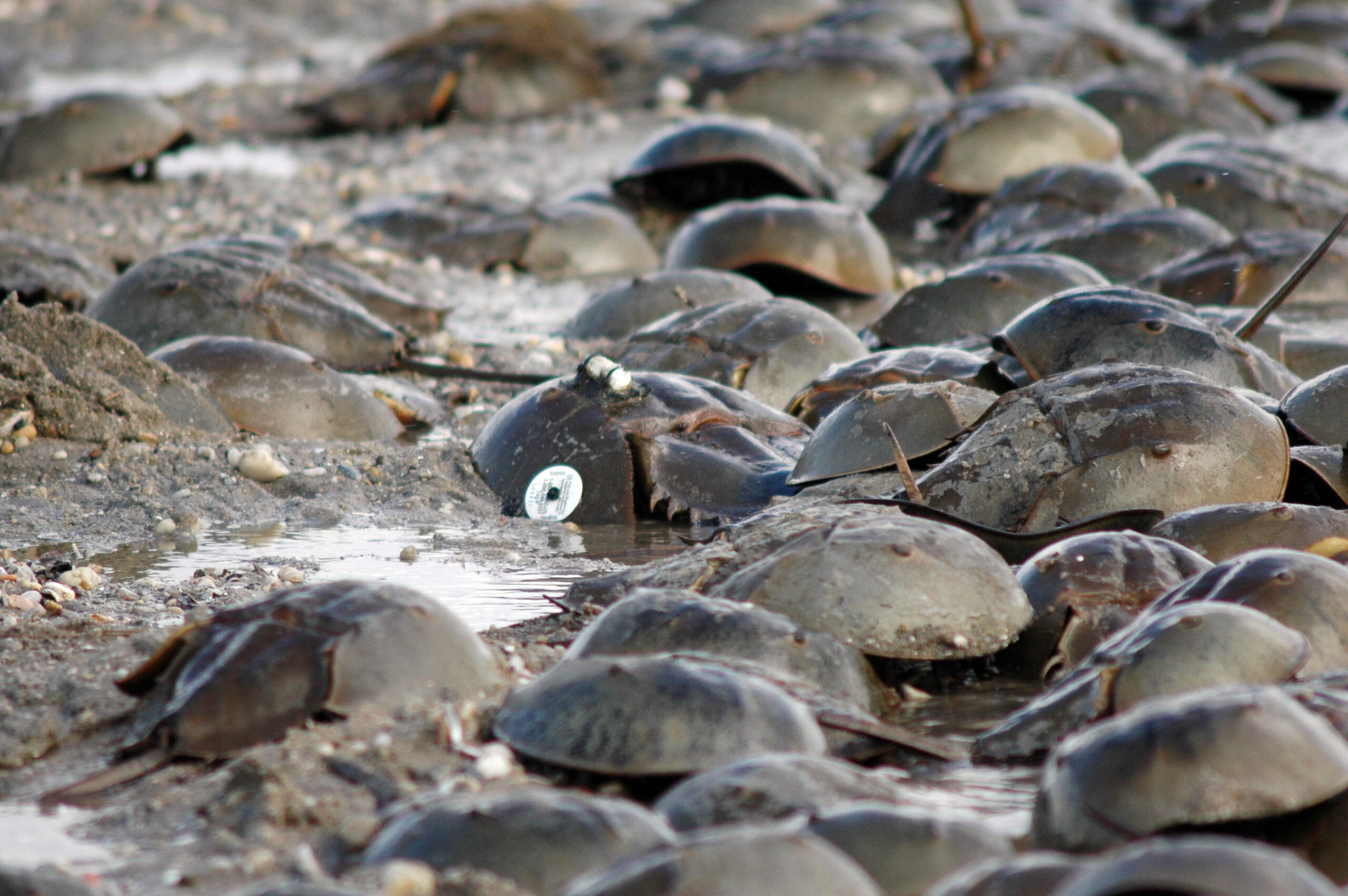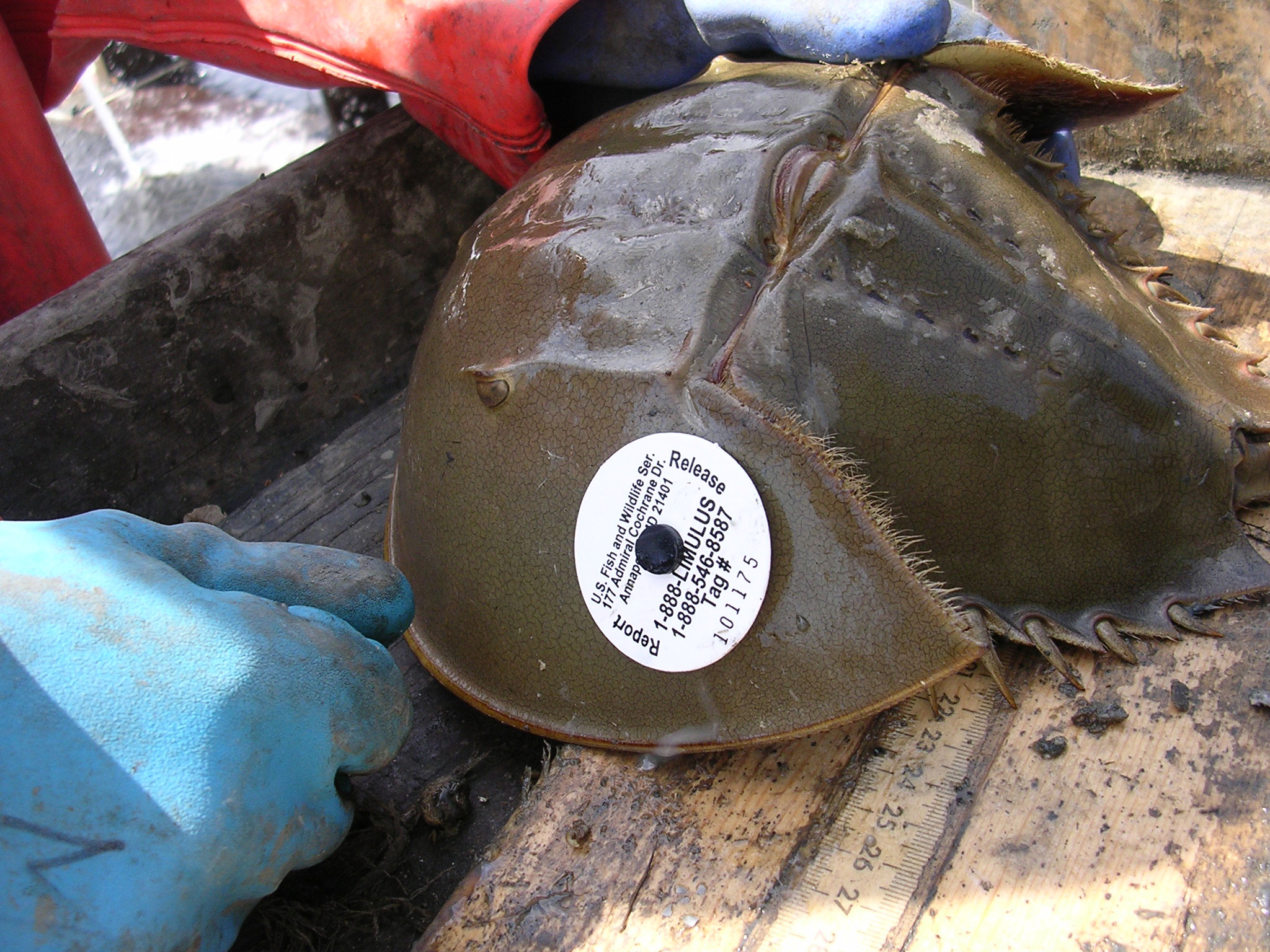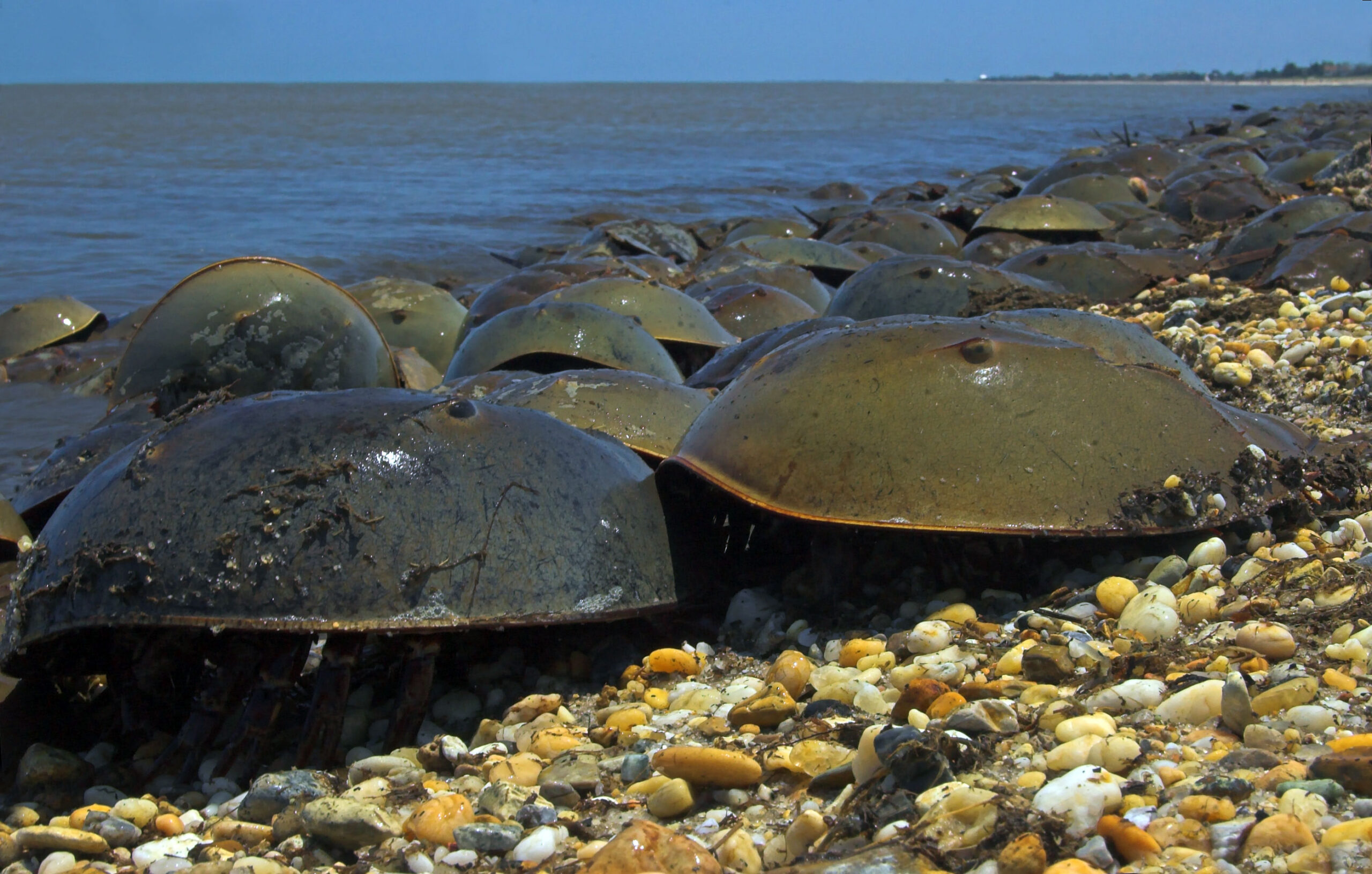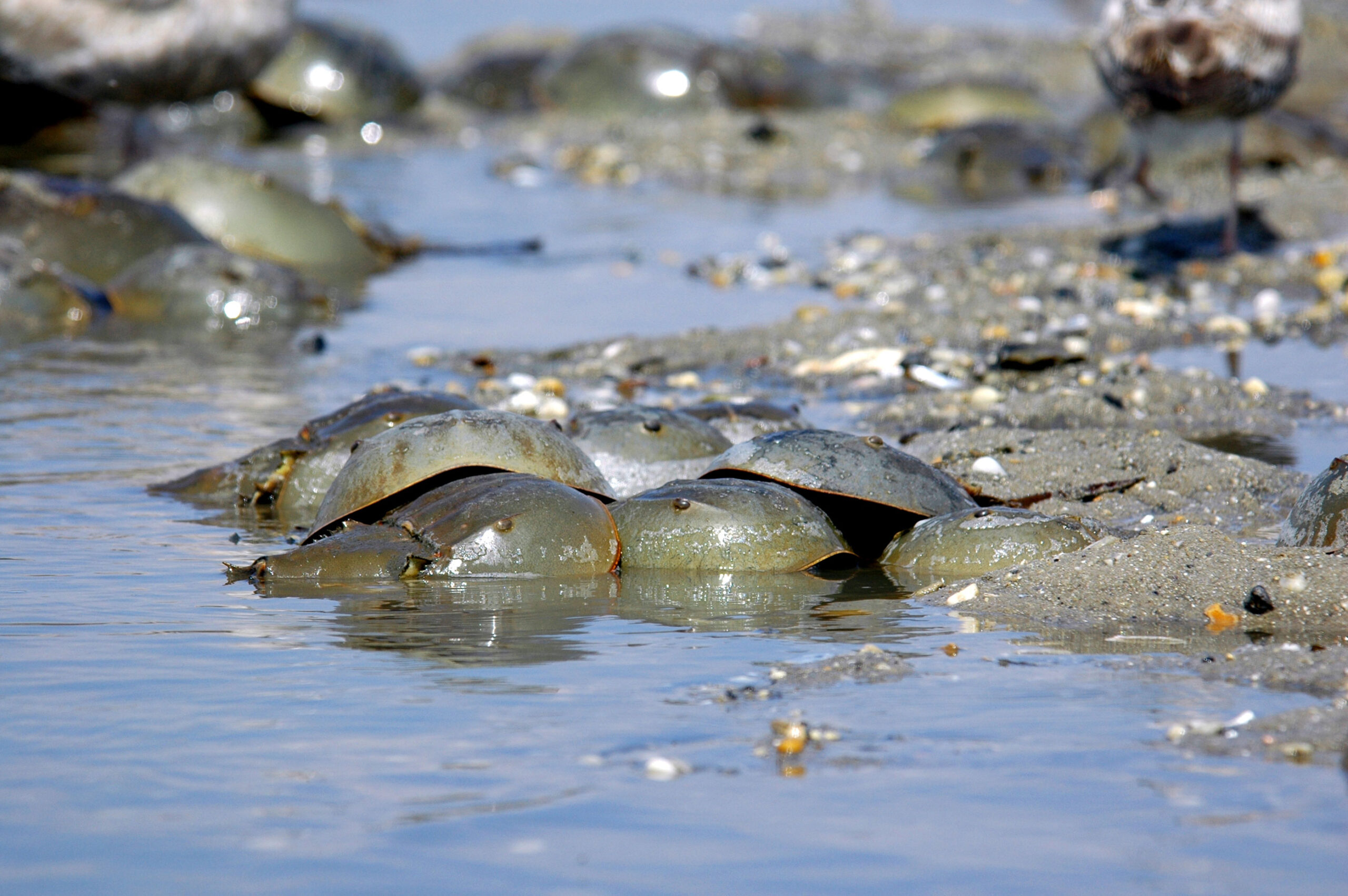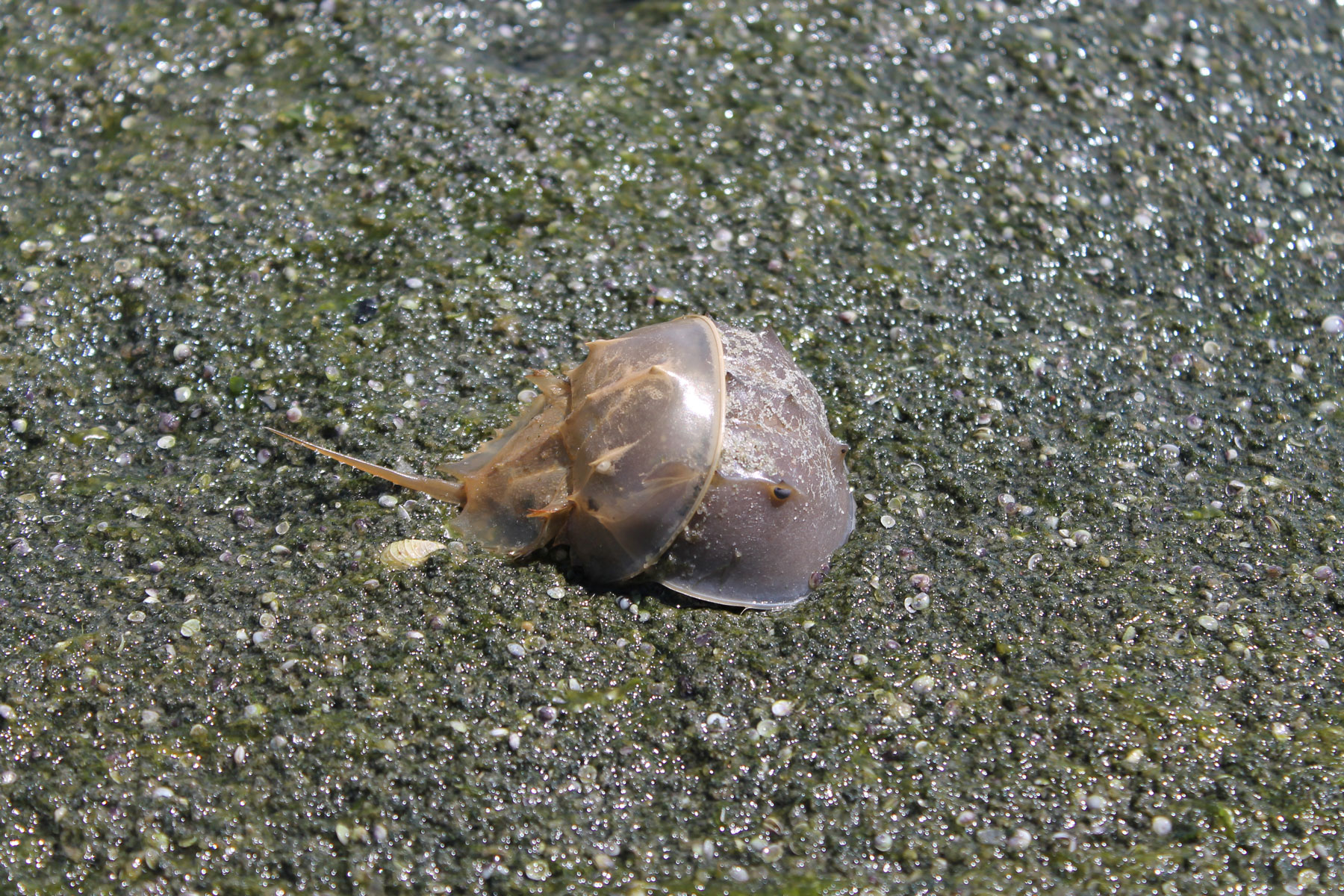Horseshoe Crab
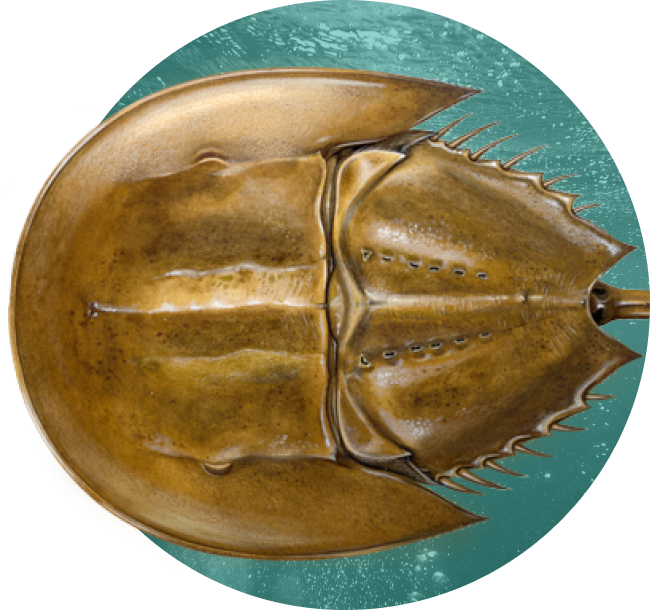
Latest News and Resources
-
ASMFC Schedules Educational Webinars for Delaware Bay Horseshoe Crab Management Stakeholder Process
-
Horseshoe Crab FMP Review – 2024
-
Horseshoe Crab Management Program Overview
-
2025 Annual Meeting Summary — October 2025
-
Delaware Bay Ecosystem Technical Committee Horseshoe Crab Harvest Recommendation for 2026 — October 2025
-
Horseshoe Crab Management Board Presentations — October 2025
-

Population Abundance
Unknown

Fishing Mortality
Unknown
Current Status
Stock status based on trend analysis in 2024 benchmark assessment update. NE region stock stable; NY region stock poor; and DE Bay and SE region stocks good. Coastwide abundance has fluctuated, with many surveys decreasing after 1998 but increasing in recent years. ARM Framework used since 2013 to set harvest levels for DE Bay-origin horseshoe crabs.
Meeting Calendar
Next Meeting
-
Recent Management Actions
Action
Status
Contacts
- Caitlin Starks, Senior FMP Coordinator (CStarks@asmfc.org)
- Management Board, Eric Reid, Chair
- Horseshoe Crab Technical Committee, Katie Rodrigue
- Delaware Bay Ecosystem Technical Committee, Wendy Walsh, Chair
- Advisory Panel, Brett Hoffmeister, Chair
Species Information
Horseshoe crabs are ancient marine arthropods inhabiting the Atlantic coast from northern Maine to the Yucatan Peninsula and the Gulf, with the Delaware Bay region hosting the largest global spawning population. They play a crucial ecological role by providing essential food for migratory shorebirds, serving as bait for commercial fisheries, and contributing to the biomedical industry through their unique blood. Managed under comprehensive Interstate Fishery Management Plans, horseshoe crabs are subject to strict quotas and adaptive management measures to balance their conservation with their diverse commercial and ecological uses, ensuring their populations continue to support both ecosystems and human industries.
Management
Horseshoe crabs are managed under the Interstate Fishery Management Plan for Horseshoe Crab (1998) and its subsequent addenda (Addenda I-VIII). Under Addendum I (2000), the Commission established state-by-state quotas in all Atlantic states for horseshoe crabs harvested for bait. Addendum II (2001) allows voluntary transfers of harvest quotas between states to alleviate concerns over potential bait shortages on a biologically responsible basis, with Commission approval. Addendum III (2004) reduced harvest quotas, implemented seasonal bait harvest closures, and revised monitoring components. In response to decreasing migratory shorebird populations, Addendum IV (2006) reduced quotas in New Jersey and Delaware and added additional protection in Maryland and Virginia to increase horseshoe crab and egg abundance in and around Delaware Bay. Addenda V and VI extended Addendum IV’s measures through 2012. The Adaptive Resource Management Framework, established through Addendum VII, incorporates both shorebird and horseshoe crab abundance levels to set optimized harvest levels for horseshoe crabs of Delaware Bay origin. It was developed in recognition of the relationship between horseshoe crab eggs and shorebirds in the Delaware Bay Region. Addendum VIII, approved in 2022, which adopts ARM Framework Revision for setting annual specifications for horseshoe crabs of Delaware Bay-origin
In October 2019, the Board directed the ARM Subcommittee to revise the ARM Framework in order to incorporate more available data and update the software platform. Several improvements to the ARM Framework were made during this revision. In the original ARM Framework, the population models for horseshoe crabs and red knots were largely based on life history information taken from literature that was not always specific to Delaware Bay. The ARM Revision improves the models for both species by incorporating region-specific data collected over the past few decades. Horseshoe crab population estimates from the Catch Multiple Survey Analysis (CMSA) model used in the 2019 Benchmark Stock Assessment were incorporated into the ARM Revision. Additionally, the ARM Revision includes more sources of horseshoe crab removals than the previous version, adding mortality in the biomedical industry and commercial discards from other fisheries.
In November 2022, the Board approved Addendum VIII, which adopts the changes to the ARM Framework as recommended in the peer-reviewed 2021 ARM Framework Revision and allows its use in setting annual bait harvest specifications for horseshoe crabs of Delaware Bay-origin. The 2021 Revision includes improvements to the ARM Framework’s population models for horseshoe crabs and red knots and incorporates more sources of horseshoe crab removal data, including mortality due to the biomedical industry and commercial discards from other fisheries. Given these improvements, which address previous peer review critiques, the ARM Revision was endorsed by the independent peer review panel as the best scientific information for the management of horseshoe crabs in the Delaware Bay Region that accounts for the forage needs of migratory shorebirds.
Under Addendum VIII, the 2021 ARM Revision will be used to annually produce bait harvest recommendations for male and female horseshoe crabs of Delaware Bay-origin, based on the abundance of horseshoe crabs and red knots. The maximum number of male and female horseshoe crabs the ARM Revision can recommend (500,000 males and 210,000 females) and the conceptual model of horseshoe crab abundance influencing red knot survival and reproduction remain unchanged, with the objective of ensuring horseshoe crab abundance does not become a limiting factor for the population growth of red knots. While the methodology for allocating the overall quota among the four Delaware Bay states is also unchanged, the state allocations have been updated to reflect the most current genetic information on the proportion of each state’s harvest that is of Delaware Bay-origin.
In May 2025, the Board approved Addendum IX, which allows the Board to set multi-year specifications for up to three years until 2031 based on the ARM Framework. In interim years when the ARM is not used, the Board will manage maximum male harvest limits based on Delaware Bay region spawning survey data. Addendum IX responds to recommendations from the July 2024 Horseshoe Crab Management Objectives Workshop, which convened a group of stakeholders to explore management objectives for the Delaware Bay-origin horseshoe crab fishery. Workshop participants recommended the Board establish an interim solution to maintain male-only harvest while changes to the Adaptive Resource Management (ARM) Framework are explored to better align the model with stakeholder values. Addendum IX also reestablishes a harvest closure for the Delaware Bay region states from January 1 through June 7, and clarifies the policy included in Addenda VII and VIII for applying Maryland and Virginia harvest caps.
Taking into consideration the recommendations of the ARM Framework Revision as well as public concern about female horseshoe crab harvest, the Board set a harvest limit of 500,000 male and zero female Delaware Bay-origin horseshoe crabs for the 2026 and 2027 fishing seasons.
Building on the July 2024 workshop, the Management Board initiated a stakeholder engagement process to evaluate the reward, utility, and harvest policy (U/R/H) functions of the ARM Framework, which are mathematical functions within the model that reflect stakeholder priorities. The process will convene participants from bait fisheries, biomedical groups, dealers, ecosystem, shorebird, and horseshoe crab conservation groups, and state and federal resource managers for a series of educational meetings and an in-person workshop. The purpose is to elicit stakeholder values and perspectives to develop clear, actionable recommendations for revising the U/R/H functions to inform possible changes to the U/R/H functions to be considered by the Board.
Stock Status
The 2019 Horseshoe Crab Benchmark Stock Assessment evaluated the stock status of the resource by region, finding populations within the Delaware Bay and Southeast regions remaining consistently neutral and good, respectively, through time. The Northeast region population changed from poor to neutral, while the status of the New York region population has trended downward from good, to neutral, and to poor. Coastwide, abundance has fluctuated through time with many surveys decreasing after 1998 but increasing in recent years. The Benchmark Assessment was endorsed by the Peer Review Panel and accepted by the Horseshoe Crab Management Board for management use.
An update of the 2019 assessment was completed in 2024. The update shows that since the 2019 assessment, the stock statuses for the Northeast, New York, and Southeast regions have remained the same (neutral, poor, and good, respectively). The Delaware Bay region status has improved from neutral to good, as has the coastwide stock status.
To date, no overfishing or overfished definitions have been adopted for management use. For the assessment, biological reference points were developed for the Delaware Bay region horseshoe crab population although not endorsed by the Peer Review Panel for use in management. However, given the assessment results of low fishing mortality and relatively high abundance, overfishing and an overfished status are unlikely for female horseshoe crabs in the Delaware Bay region.
In the absence of biological reference points, stock status is based on the percentage of surveys within a region (or coastwide) having a >50% probability of the final year (2022) being below their 1998 levels. “Poor” status was >66% of surveys meeting this criterion, “Good” status was <33% of surveys, and “Neutral” status was 34 – 65% of surveys.
In April 2024, the Board accepted the stock assessment update for management use. At that meeting, it also considered a report from the ARM Subcommittee responding to the critique of the revised ARM Framework produced by Earthjustice. After conducting a thorough review and technical evaluation of the specific issues raised in the critique, the ARM Subcommittee maintains the red knot and horseshoe crab population models used in the ARM Framework represent the best use of the available data. Further, trawl surveys and egg density data indicate an increase in horseshoe crab populations in the region, a result consistent with the stock assessment update. The Subcommittee concluded that the Earthjustice critique was largely unfounded and failed to offer any alternative management approaches. As science and modeling approaches evolve, the Subcommittee will continue to revise and improve the ARM Framework for managing the Delaware Bay horseshoe crab fishery. The Subcommittee report can be found here.
Commercial Fishery & Biomedical Use
Horseshoe crabs are at the center of one of the most interesting marine resource management issues along the Atlantic coast. In addition to their role as a food source for birds, horseshoe crabs provide bait for commercial American eel and conch fisheries along the coast. Their unique blood is also used by the biomedical industry to produce Limulus Amoebocyte Lysate (LAL), which is used to test medical products for contamination. The challenge of fisheries managers is to ensure that horseshoe crabs are managed to meet all these diverse needs, while conserving the resource for future generations.
From the 1850s to the 1920s, between 1.5 and 2 million horseshoe crabs were harvested annually for fertilizer and livestock feed. Harvest declined throughout the 1950s and ceased in the 1960s. Between 1970 and 1990, reported commercial harvest ranged from less than 20,000 pounds to greater than two million pounds annually. Since the mid- to late 1990s, commercial harvest has primarily been sold as bait for the American eel and whelk pot fisheries. An increase in demand for bait for the whelk fishery likely caused an upsurge in horseshoe crab harvest in the 1990s, with a peak of nearly six million pounds harvested in 1997. Since the implementation of state quotas in 2000, total landings have remained below the coastwide quota (1.59 million crabs). Reported coastwide bait landings in 2024 totaled about 550,908 horseshoe crabs. In more recent years, commercial fishermen have adopted new gear such as bait bags and cups that have improved the efficiency of horseshoe crab bait; with these gears they are able to effectively catch eel and conch using as little as a tenth of the amount of bait previously used per pot.
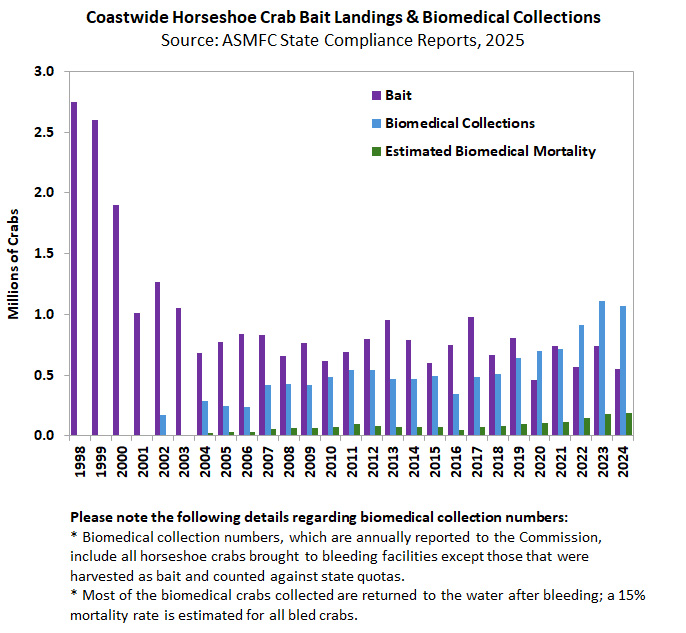
The majority of horseshoe crab harvest comes from the Delaware Bay Region, followed by the New York, New England, and the Southeast regions. Trawls, hand harvests and dredges make up the bulk of commercial horseshoe crab bait landings. Horseshoe crabs are discarded from commercial gears including dredges, trawls and gillnets. Estimates of discards and associated mortalities are highly variable and have large associated errors. However, the 2019 benchmark stock assessment and 2024 assessment update suggest significant increases in discards and discard mortality in the Delaware Bay region. The number of dead horseshoe crabs due to discarding can vary from about a fourth to half of the number of crabs harvested for bait. Discard mortality impacts both males and females, as well as mature and immature crabs. However, in the Delaware Bay region, only male crabs may be harvested as bait, and these are typically adults. Discards in the Delaware Bay region have increased notably since 2013, when male-only bait harvest was required for the entire region through the Adaptive Resource Management (ARM) Framework.
Horseshoe crabs are also collected by the biomedical industry to support the production of LAL, a clotting agent that aids in the detection of human pathogens in patients, drugs, and intravenous devices. Blood from the horseshoe crab is obtained by collecting adults and extracting a portion of their blood. Most crabs collected and bled by the biomedical industry are, as required by the FMP, released alive to the water from where they were collected; however, a portion of these crabs die from the procedure. Crabs harvested for bait are sometimes bled prior to being processed and sold by the bait industry; these crabs are counted against the bait quota. Biomedical use has increased since 2004, when reporting began. In 2024, 1,073,329 horseshoe crabs were collected coastwide solely for biomedical purposes, and the total estimated biomedical mortality was 184,693 horseshoe crabs. Biomedical data were included as part of the 2019 benchmark stock assessment and 2024 update and continue to be provided to the Commission annually through state compliance reports, although the data remain confidential to the public at a regional or state level.
Life History
Horseshoe crabs (Limulus polyphemus) are marine arthropods found along the Atlantic coast from northern Maine to the Yucatan Peninsula and the Gulf. The Delaware Bay supports the largest spawning population in the world. Adults either remain in estuaries or migrate to the continental shelf during the winter months. Migrations resume in the spring when the horseshoe crabs move to beach and estuarine areas to spawn. Juveniles hatch from the coastal environment and spend the first two years in nearshore areas.
Spawning usually coincides with the high tide during the full and new moon. Breeding activity is consistently higher during the full moon than the new moon and is also greater at night. Adults prefer sandy beach areas within bays and coves that are protected from surf. Females lay their eggs in clusters or nest sites along the beach; females lay approximately 90,000 eggs per year in various egg clusters.
Horseshoe crab eggs play an important ecological role in the food web for migrating shorebirds. The Delaware Bay Estuary is the largest staging area for shorebirds in the Atlantic Flyway. An estimated 425,000 to one million migratory shorebirds converge on the Delaware Bay to feed and rebuild energy reserves prior to completing their northward migration.
News & Resources
Explore recent news, management updates, and scientific reports to gain a deeper understanding of ongoing conservation efforts and sustainability strategies.
-
The Commission’s Horseshoe Crab Management Board is convening a stakeholder engagement process to inform revisions to the Delaware Bay Horseshoe Crab Adaptive Resource Management (ARM) Framework, including a series of three educational webinars and an in-person stakeholder workshop. The process will be facilitated by Compass Resource Management with the goal of identifying stakeholder values and…
-
-
Prepared for the Commissioner Manual
-
A summary of all the board meetings, press releases and motions from the 2025 Annual Meeting.
-
This memo describes the 2026 harvest recommendation for Delaware Bay Region horseshoe crabs using the methods from the Adaptive Resource Management (ARM) Framework (ASMFC 2022a).
-
-
The Commission’s Horseshoe Crab Management Board approved bait harvest specifications for horseshoe crabs of Delaware Bay-origin. Taking into consideration the output of the Adaptative Resource Management (ARM) Framework, the Board set an annual harvest limit of 500,000 male horseshoe crabs and zero female Delaware Bay-origin horseshoe crabs for 2026 and 2027. Addendum IX was approved…
-
Delaware Bay Ecosystem Technical Committee and Adaptive Resource Management Subcommittee Memo: Delaware Bay Horseshoe Crab Harvest Recommendation for 2026; Horseshoe Crab Adaptive Resource Management Subcommittee & Delaware Bay Ecosystem Technical Committee Meeting Summary September 2025
-
-
Set Delaware Bay Bait Harvest Specifications Final Action, Review Horseshoe Crab and Red Knot Abundance Estimates and Model Results from the Adaptive Resource Management Framework (J. Sweka), Set Specifications for the 2026 Fishing Year or Up to Three Years (C. Starks); Update on Stakeholder Engagement Process Planning for Evaluating ARM Reward, Utility, and Harvest Policy…
-
-
The Commission’s Horseshoe Crab Management Board is initiating a collaborative stakeholder process to inform revisions to the Delaware Bay Horseshoe Crab Adaptive Resource Management (ARM) Framework. Stakeholders that would like to participate in this important conversation on the management of the Delaware Bay horseshoe crab resource are invited to apply. Applications should be submitted here…
-
-
-
The Adaptive Resource Management (ARM) Subcommittee and the Delaware Bay Ecosystem Technical Committee (DBETC) met via webinar to review the most recent population estimates for horseshoe crabs and red knots, the harvest recommendations from the ARM for the 2026 fishing year and supporting horseshoe crab and red knot data sets. Below are the agenda items…
Get Hooked on ASMFC News
Dive into the latest updates and catch all the important news by joining our newsletter mailing list. Stay in the loop with meeting agendas, fisheries management news, and more.
